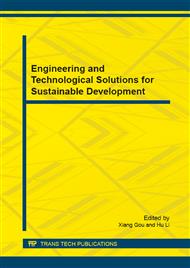[1]
M.V. Gil, J. Riaza, L. Álvarez, Kinetic models for the oxy-fuel combustion and coal/biomass blend chars obtained in N2 and CO2 atmosphere, Energy. 48 (2012) 510-518.
DOI: 10.1016/j.energy.2012.10.033
Google Scholar
[2]
A.G. Borrego, L. Garavaglia, W.D. Kalkreuth, Characteristics of high heating rate biomass char prepared under N2 and CO2 atmospheres, Int. J. Coal. Geol. 77 (2009) 409-415.
DOI: 10.1016/j.coal.2008.06.004
Google Scholar
[3]
C.A. Wang, X.M. Zhang, Y.H. Liu, Pyrolysis and combustion characteristics of coals in oxyfuel combustion, Appl. Energ. 97 (2012) 264-273.
DOI: 10.1016/j.apenergy.2012.02.011
Google Scholar
[4]
Z.Y. Luo, Y.R. Mao, X.C. Wu, Test study on and analysis of burning behavior for coal under atmosphere of O2/CO2, Thermal power generation. 06 (2004) 14-18.
Google Scholar
[5]
J. Pang, J. Zhang, Effects of gas temperature fluctuation on the instantaneous pyrolysis of biomass pariticles, J. Anal. Appl. Pyrol. 108 (2014) 196-202.
DOI: 10.1016/j.jaap.2014.04.016
Google Scholar
[6]
X.B. Wang, W.G. Xu, W.X. Jin, Effect of pyrolysis temperature on the chemical physical characteristics of biomass char, Journal of Fuel Chemistry and Technology. 41 (2013) 74-78.
Google Scholar
[7]
G. Duman, M.A. Uddin, J. Yanik, The effect of char properties on gasification reactivity, Fuel Process. Technol. 118 (2014) 75-81.
DOI: 10.1016/j.fuproc.2013.08.006
Google Scholar
[8]
J.Z. Liu, M.Q. Liu, W.D. Zhao, Thermogravimetric study on combustion of lignite semicoke, Thermal Power Generation. 42 (2013) 86-92.
Google Scholar
[9]
K. Luo, H.P. Chen, X.H. Wang, Characterization of bio-char and its characteristics, Renew. Energ. 25 (2007) 17-22.
Google Scholar
[10]
K.H. Hou, J.A. Drahun, A.V. Bridgwater, Influence of preparation conditions on the combustion reactivity of chars produced from the fast pyrolysis of biomass, Journal of Fuel Chemistry and Technology. 33 (2005) 450-455.
Google Scholar
[11]
D.F. Liu, X.L. Wei, H.Z. Sheng, Thermogravimetric experimental study on combustion characteristics of semicoke, Journal of Engineering Thermophysics. 28 (2007) 229-232.
Google Scholar
[12]
Z.J. Hu, Z.J. Liu, S.J. Wang, Characteristics of NO release during coal char combustiom, Chem. Eng. 34 (2006) 16-19.
Google Scholar
[13]
W.Y. Liu, X. Gou, L.S. Liu, Experimental study on NO emission characteristics of corn stalk combustion in O2/CO2 and O2/N2 atmospheres, Anvanced Materials Research. 602-604 (2013) 1059-1063.
Google Scholar
[14]
J.S. Xie, S.Q. Cheng, H.M. Zhang, Experimental study on NO emission characteristic: co-firing of biomass and coal in O2/CO2 atmosphere, Thermal Power Generation. 41 (2012) 32-36.
Google Scholar
[15]
Y.J. Li, C.S. Zhao, L.B. Duan, A thermodynamic analysis of coal aombustion products in O2/CO2 atmosphere, Journal of Engineering for Thermal Energy and Power. 22 (2007) 332-335.
Google Scholar
[16]
C.M. Chen, C.S. Zhao, K.L. Pang, Experimental study on NOX emission from coal combustion under O2/CO2 atmosphere, Journal of Southeast University(Natural Science edition). 35 (2005) 738-741.
Google Scholar
[17]
Y.C. Zhang, J. Zhang, Y.X. Liu, NOX emission characteristics of blended coal combustion in O2/CO2 atmosphere, Journal of Southeast University(Natural Science edition). 40 (2010) 992-996.
Google Scholar


